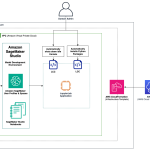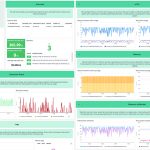Stock technical analysis questions can be as unique as the individual stock analyst themselves. Queries often have multiple technical indicators like Simple Moving Average (SMA), Exponential Moving Average (EMA), Relative Strength Index (RSI), and others. Answering these varied questions would mean writing complex business logic to unpack the query into parts and fetching the necessary data. With the number of indicators available, the possibility of having one or many of them in any combination, and each of those indicators over different time periods, it can get quite complex to build such a business logic into code.
As AI technology continues to evolve, the capabilities of generative AI agents continue to expand, offering even more opportunities for you to gain a competitive edge. At the forefront of this evolution sits Amazon Bedrock, a fully managed service that makes high-performing foundation models (FMs) from Amazon and other leading AI companies available through a single API. With Amazon Bedrock, you can build and scale generative AI applications with security, privacy, and responsible AI. Amazon Bedrock Agents plans and runs multistep tasks using company systems and data sources—from answering customer questions about your product availability to taking their orders. With Amazon Bedrock, you can create an agent in just a few quick steps by first selecting an FM and providing it access to your enterprise systems, knowledge bases, and actions to securely execute your APIs. These actions can be implemented in the cloud using AWS Lambda, or you can use local business logic with return of control. An agent analyzes the user request and automatically calls the necessary APIs and data sources to fulfill the request. Amazon Bedrock Agents offers enhanced security and privacy—no need for you to engineer prompts, manage session context, or manually orchestrate tasks.
In this post, we create a virtual analyst that can answer natural language queries of stocks matching certain technical indicator criteria using Amazon Bedrock Agents. As part of the agent, we configure action groups consisting of Lambda functions, which gives the agent the ability to perform various actions. The Amazon Bedrock agent will transform the user natural language query into relevant Lambda calls, passing the technical indicators and their needed duration. Lambda will access the open source stock data pre-fetched into an Amazon Simple Storage Service (Amazon S3) bucket, calculate the technical indicator in real time, and pass it back to the agent. The agent will take further actions like other Lambda calls or filtering and ordering based on the task.
Solution overview
The technical analysis assistant solution will use Amazon Bedrock Agents to answer natural language technical analysis queries, from simple ones like “Can you give me a list of stocks in the NASDAQ 100 index” to complex ones like “Which stocks in the NASDAQ 100 index has both grown over 10% in last 6 months and also closed above their 20-day SMA?” Agents orchestrate and analyze the task and break it down into the correct logical sequence using the FM’s reasoning abilities. Agents automatically call the necessary Lambda functions to fetch the relevant stock technical analysis data, determining along the way if they can proceed or if they need to gather more information.
The following diagram illustrates the solution architecture.

The workflow consists of the following steps:
- The solution spins up a Python-based Lambda function that fetches the daily stock data for the last one year using the
yfinancepackage. The Lambda function is triggered to run every day using an Amazon EventBridge The functions puts the last 1-year stock data into an S3 bucket. - A user asks a natural language query, like “Can you give me a list of stocks in NASDAQ 100 index” or “Which stocks have closed over both 20 SMA and 50 EMA in the FTSE 100 index?”
- This query is passed to the Amazon Bedrock agent powered by Anthropic’s Claude 3 Sonnet. The agent deconstructs the user query, creates an action plan, and executes it step-by-step to fetch various data needed to answer the question. To fetch the needed data, the agent has three action groups, each powered by a Lambda function that can use the raw data stored in the S3 bucket to calculate technical indicators and other stock-related information. Based on the response from the action group and the agent’s plan of action, the agent will continue to make calls or take other actions like filtering or summarizing until it arrives at the answer to the question. The action groups are as follows:
- get-index – Get the stock symbol of constituents for a given index. The example currently has constituents configured for Nasdaq 100, FTSE 100, and Nifty 50 indexes.
- get-stock-change – For a given stock or list of stocks, calculate the change percentage over a given period based on the pre-fetched raw data in Amazon S3. This solution currently is configured to have data of the past 1 year.
- get-technical-analysis – For a given stock or list of stocks, calculate the given technical indicator for a given time period. It also fetches the last closing price of the stock based on the pre-fetched raw data in Amazon S3. This solution currently is configured to handle SMA, EMA, and RSI technical indicators for up to 1 year.
Prerequisites
To set up this solution, you need a basic knowledge of AWS and the relevant AWS services. Additionally, request model access on Amazon Bedrock for Anthropic’s Claude 3 Sonnet.
Deploy the solution
Complete the following steps to deploy the solution using AWS CloudFormation:
- Launch the CloudFormation stack in the
us-east-1AWS Region:
- For Stack name, enter a stack name of your choice.
- Leave the rest as defaults.
- Choose Next.
- Choose Next
- Select the acknowledgement check box and choose Submit.

- Wait for the stack creation to complete.
- Verify all resources are created on the stack details page.
The CloudFormation stack creates the solution described in the solution overview and the following key resources:
- StockDataS3Bucket – The S3 bucket to store the 1-year stock data.
- YfinDailyLambda – A Python Lambda function to fetch the last 1-year stocks data in the Nasdaq 100, FTSE 100 and Nifty 50 indexes from Yahoo Finance using the
yfinancepackage:
- YfinDailyLambdaScheduleRule – An EventBridge rule to trigger the
YfinDailyLambdafunction daily to get the latest stock data. - InvokeYfinDailyLambda and InvokeLambdaFunction – A custom CloudFormation resource and its Lambda function to invoke the
YfinDailyLambdafunction as part of the stack creation to fetch the initial data. - GetIndexLambda – This function takes in an index name as input and returns the list of stocks in the given index.
- GetStockChangeLambda – This function takes a list of stocks and number of days as input, fetches the stock data from the S3 bucket, calculates the percentage change over the period for the stocks, and returns the data.
- GetStockTechAnalysisLambda – This function takes a list of stocks, number of days, and a technical indicator as input and returns the last close and the technical indicator over the number of days for the given list of stocks. For example:
- StockBotAgent – The Amazon Bedrock agent created with Anthropic’s Claude 3 Sonnet model with three action groups, each mapped to a Lambda function. We give the agent instructions in natural language. In our solution, part of our instruction is that “You can fetch the list of stocks in a given index” so the agent knows it can fetch stocks in an index. We configure the action groups as part of the agent and use the OpenAPI 3 schema standard to describe the Lambda functionality, so the agent understands when and how to invoke the Lambda functions. The following is a snippet of the get-index action group OpenAPI schema where we describe its functionality, its input and output parameters, and format:
Test the solution
To test the solution, complete the following steps:
- On the Amazon Bedrock console, choose Agents in the navigation pane.
- Choose the agent created by the CloudFormation stack.

- Under Test, choose the alias with the name Version 1 and expand the Test

Now you can enter questions to interact with the agent.
- Let’s start with the query “Can you give me a list of stocks in Nasdaq.”
You can see the answer in the following screenshot. Expand the Trace Step section in the right pane to see the agent’s rationale and the call to the Lambda function.

- Now let’s ask a question that is likely to use all three action groups and their Lambda functions: “Can you give list of stocks that has both grown over 10% in last 6 months and also closed above their 20-day SMA. Use stocks from the Nasdaq index.”
You will get the response shown in the following screenshot, and in the trace steps, you will see the various Lambda functions being invoked at different steps as the agent reasons through the steps to get to the answer to the question.



You can further test with additional prompts, such as:
- Can you give the top three gainers in terms of percentage in the last 6 months in the Nifty 50 index?
- Which stocks have closed over both 20 SMA and 50 EMA in the FTSE 100 index?
- Can you give list of stocks that has grown over 10% in last 6 months and closed above 20-day SMA and 50-day EMA. Use stocks from the FTSE 100 index. Follow up question: Of these stocks, are there any that have grown over 25% in the last months? If so, can you give me the stocks and their growth percent over 6 months?
Programmatically invoke the agent
When you’re satisfied with the performance of your agent, you can build an application to programmatically invoke the agent using the InvokeAgent API. The agent ID and the agent alias ID needed for invoking the agent alias programmatically can be found on the Outputs tab of the CloudFormation stack, titled AgentId and AgentAliasId, respectively. To learn more about the programmatic invocation, refer the following Python example and JavaScript example.
Clean up
To avoid charges in your AWS account, clean up the solution’s provisioned resources:
- On the Amazon S3 console, empty the S3 bucket created as part of the CloudFormation stack. The bucket name should start with your stack name that you entered while creating the CloudFormation stack. You can also check the name of the bucket on the CloudFormation stack’s Resources
- On the AWS CloudFormation console, select the stack you created for this solution and choose Delete.
Conclusion
In this post, we showed how you can use Amazon Bedrock Agents to carry out complex tasks that need multiple step orchestration through just natural language instructions. With agents, you can automate tasks for your customers and answer questions for them. We encourage you to explore the Amazon Bedrock Agents User Guide to understand its capabilities further and use it for your use cases.
About the authors
 Bharath Sridharan is a Senior Technical Account Manager at AWS and works with strategic customers of AWS in pro-actively optimizing their workloads on AWS. Bharath additionally specializes on Machine learning services of AWS with a focus on Generative AI.
Bharath Sridharan is a Senior Technical Account Manager at AWS and works with strategic customers of AWS in pro-actively optimizing their workloads on AWS. Bharath additionally specializes on Machine learning services of AWS with a focus on Generative AI.


